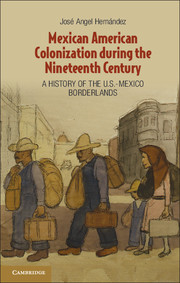 Mexican American Colonization during the Nineteenth Century
Mexican American Colonization during the Nineteenth Century Book contents
- Frontmatter
- Contents
- Figures
- Acknowledgments
- Introduction
- Part I Migration to Mexico in an Age of Global Immigrations
- Chapter One From Conquest to Colonization
- Chapter Two Postwar Expulsions and Early Repatriation Policy
- Part II México Perdido and the Making of Postwar Repatriation Programs Along the Borderlands
- Chapter Three Postwar Repatriation and Settling the Frontiers of New Mexico
- Chapter Four Repatriations Along the International Boundary
- Part III The Local Mixing, Unmixing, and Remixing of a Repatriate Colony in Chihuahua
- Chapter Five The 1871 Riot of La Mesilla, New Mexico
- Chapter Six Colonizing La Ascensión, Chihuahua
- Chapter Seven Anatomy of The 1892 Revolt of La Ascensión, or the Public Lynching of Rafael Ancheta
- Conclusion Repatriating Modernity?
- Bibliography
- Index
- References
Chapter Seven - Anatomy of The 1892 Revolt of La Ascensión, or the Public Lynching of Rafael Ancheta
Published online by Cambridge University Press: 05 June 2012
- Frontmatter
- Contents
- Figures
- Acknowledgments
- Introduction
- Part I Migration to Mexico in an Age of Global Immigrations
- Chapter One From Conquest to Colonization
- Chapter Two Postwar Expulsions and Early Repatriation Policy
- Part II México Perdido and the Making of Postwar Repatriation Programs Along the Borderlands
- Chapter Three Postwar Repatriation and Settling the Frontiers of New Mexico
- Chapter Four Repatriations Along the International Boundary
- Part III The Local Mixing, Unmixing, and Remixing of a Repatriate Colony in Chihuahua
- Chapter Five The 1871 Riot of La Mesilla, New Mexico
- Chapter Six Colonizing La Ascensión, Chihuahua
- Chapter Seven Anatomy of The 1892 Revolt of La Ascensión, or the Public Lynching of Rafael Ancheta
- Conclusion Repatriating Modernity?
- Bibliography
- Index
- References
Summary
THELINCHAMIENTO OF RAFAEL ANCHETA
At five o’clock on the afternoon of January 6, 1892, 100 armed men gathered behind the Church of La Ascensiόn to confront the newly elected municipal president, Rafael Ancheta of the regional ruling party. Angry, intoxicated, and armed, the residents of this repatriate colony on the Chihuahua–New Mexico border questioned the legitimacy of Rafael Ancheta’s election victory over the preferred, and more popular, independent candidate José León Urrutía . Warned of the discontent and the brewing rebellion, Ancheta went behind the church with several men, also armed, to inquire about the gathering. There Ancheta was met by locals who claimed that he should not be the municipal president and that they had gathered to “un-recognize his authority.”
In the argument that ensued between Ancheta and the rebels, Atilano Baca , past municipal president and one of the main leaders of the opposition, accused Ancheta of being “nothing more than an infamous ingrate that wants to be an authority by force.” Ancheta maintained that he was the legally elected president of the municipality. At some point during this heated exchange, which had fueled an already angry crowd, someone knocked Ancheta unconscious with a rifle butt to the head and then dragged him by a rope to a mill owned by Remigio Saenz situated just outside the colony. One of the police accompanying Ancheta, José Ávalos Salazar , was gravely wounded in the rioting, barely escaping the mob to reach the home of postmaster Marcos Sifuentes , where he died later that evening. On the way to the Saenz mill, people kicked and beat Ancheta, and once in the mill he suffered further torture, gunshots, beatings, and humiliations until a blow to his head from a pickaxe killed him three days later. Back in the colony, local prisoners, some of whom were related to the rebellious repatriates, were released from the jail without resistance from the guards. With such a well-fortii ed position in the mill, the number of revoltosos grew to well over 130 men.
- Type
- Chapter
- Information
- Mexican American Colonization during the Nineteenth CenturyA History of the U.S.-Mexico Borderlands, pp. 203 - 224Publisher: Cambridge University PressPrint publication year: 2012


